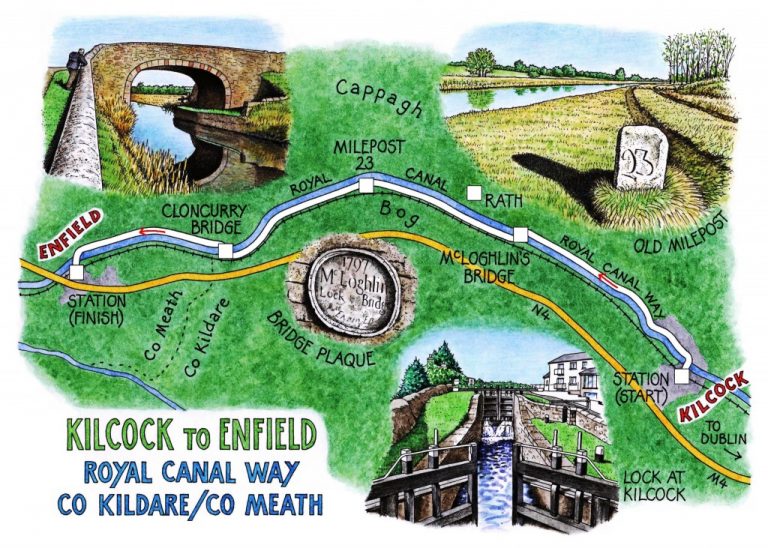Irish Independent – WALK OF THE WEEK – Christopher Somerville
16 April 2011
92. Kilcock to Enfield, Royal Canal Way, Cos. Kildare/Meath

A peerless peach of an early spring afternoon – cold bracing air, warm caressing sun, and a bowl of kingfisher-blue sky inverted over County Kildare. The green and silver train eased into Kilcock, as smooth as Sinatra. We disembarked, crossed the railway, and slipped straight away into canal country.
Walking west along the Royal Canal into the heart of Ireland, the only sign of a bulge in the landscape was the rise of the Wicklow Hills, far and blue behind us in the east. There was nothing to detract from what was near at hand – mallard drakes with brilliant green heads in hot pursuit of ducks in speckled brown plumage; a blue tit squeaking like a rusty bicycle wheel from the top of an ash tree; three sleepy heifers regarding us with round eyes from their communal huddle in a nearby field; a black labrador plunging like a belly-flopping swimmer into the canal after a stick.
The water lay as still as looking-glass. You’d scarcely believe a boat had ever passed among these fields, let alone the full drama of the canal’s chequered history. The Royal Canal is a rackety old lady with a purple past, the down-at-heel younger sister of the swankier and better regulated Grand Canal. Like the Grand, the ambitious aim of the Royal was to carry goods and people from the port of Dublin across Ireland to the River Shannon, and thence to the west coast. But from the cutting of the first sod in Dublin in 1790 the Royal was beset with problems – extra-long and difficult rock cuttings, sloppy peat bogs, drainage problems, leaks, bursts, wobbly banks. The first 15 miles consumed five years’ work and all the company’s money. After that, everything was done on borrowed funds, overshadowed by a mountain of debt. By the time she limped into Termonbarry on the Shannon in Co. Longford, ninety miles and 27 years later, the canal had cost the company £1.5 million – the best part of €100 million in today’s money.
Other than the occasional rattle of a train on the canalside line, and the wind-like rush and sigh of the distant Galway road, there were no man-made noises to disturb our walk. Every few miles a gracefully curved bridge crossed the canal, taking us with the towpath up and over to the opposite bank. On the bridge above the spouting wooden gates at Lock 17, a finely carved stone plaque recorded ‘1797: McLoghlin’s Lock & Bridge – Engineer’.
Anti-canal feeling ran high in the early days, amid fears that the Royal would bring in thieving, heathen strangers and carry away locals and their livelihoods. Ribbonmen would pelt the bargees from the bridges with stones and filth. Others were cannier, breaching the canal walls to let the water out, then offering themselves as handymen for the repair job at 14 shillings a week – good money. That scam only stopped when the company put a ban on hiring local labour.
Out on the edge of Cappagh Bog we passed the lumpy whaleback of a rath, its earthen ramparts pierced by a gateway and crowned with thorn bushes. A canalside farm stood silent among trees whose brushy branches reached into the blue sky, perfectly reflected in unruffled water with a black mirror sheen. A stout blue dredger reached motionless praying-mantis arms into the canal. Three swans sailed by. Images of peace and continuity, at odds in every way with those we’d left back there in the outside world.
The poor old Royal, slow and clumsy, was half-strangled by the coming of the railways in the 1840s, and mortally wounded by the motor lorry in the early years of the 20th century. She struggled on, haemorrhaging money and trade, until the 1950s; then she gave up ghost for good. Or so it seemed. The Royal Canal Amenity Group, formed in 1974 to restore the canal to full navigation, had other ideas. And on 1 October last year, a day of great celebration, their dream came true when a flotilla of boats took a ceremonial cruise from Dublin to the Shannon along the refurbished and newly re-opened Royal Canal.
Jane and I crossed from Kildare into Meath, and came into Enfield towards dusk after a timeless afternoon’s walk. On the station platform we found a creaky old signal box and an ancient, ivy-grown water tower, waiting for a steam engine to arrive out of a crack in the space-time continuum. So maybe time really had slipped its moorings today.
WAY TO GO
MAP: OS of Ireland 1:50,000 Discovery 49; downloadable map/instructions at www.discoverireland.ie/walking.
GPS: satmap.com
TRAVEL:
Rail (www.irishrail.ie) to Kilcock; return from Enfield.
Bus (www.buseireann.ie): 115 Dublin-Longford
Road: M4/N4
WALK DIRECTIONS: From Kilcock station, cross Royal Canal; left along towpath (‘Royal Canal Way’) and follow it to Enfield.
LENGTH: 8 miles: allow 3-4 hours
GRADE: Easy
CONDITIONS: One or two stretches very muddy. Mostly buggy/bike/dog friendly.
DON’T MISS … !
• beautiful wildflowers
• stone-carved plaque on McLoghlin’s Bridge
• old-fashioned water tower and signal-box at Enfield
REFRESHMENTS: Aglio Restaurant, Enfield (046-954-9718) – great pizzas
GUIDE BOOK: Towpath Tours by John Dunne (Collins Press)
WALKING in IRELAND: Walking tour operators, local walks including Discover Ireland’s National Loop Walks, walking festivals throughout Ireland: www.discoverireland.ie/walking.
Tinahely Trailwalking Festival, Co. Wicklow: 29 April-2 May (www.tinahely.ie)
Donegal Bluestack Walking Festival: 30th April-1 May (087-784-4803;
www.donegalwalkerswelcome.com)
Barrow Way Challenge Walk: Robertstown-St Mullins (70 miles), Friday 6-Sunday 8 May – info 087-220-6360; mgrainger@mobileemail.vodafone.ie
NB New ‘Walk Safely’ leaflet (Mountaineering Ireland & Fáilte Ireland) from TICs or info@mountaineering.ie (01-625-1115); download from www.mountaineering.ie.
INFORMATION: Kildare Town Heritage Centre, Market Square, Kildare (045-530672; www.kildare.ie/kildareheritage
csomerville@independent.ie